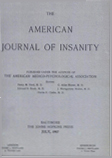ELECTROENCEPHALOGRAPHY IN SCHIZOPHRENIA
Abstract
1. The EEG. tracings from 500 schizophrenic patients are compared with the records from 215 normal controls. A significantly greater percentage of borderline and abnormal records was found in the schizophrenic patients.
2. A greater percentage of the abnormal records in the schizophrenic patients was found in the catatonic-hebephrenic group.
3. There is nothing consistent or diagnostic in the character of the EEG. tracings of schizophrenic patients, a great variety of records being obtained. Rapid activity is common but is not of diagnostic significance because similar activity is found in other neuropsychiatric disorders, particularly in the manic-depressives, agitated depressions of middle age and in neurosyphilitics.
4. Our studies show no significant relationship between schizophrenia and epilepsy on the basis of the EEG. patterns.
5. With the psychoses an expression of the dynamic forces of the total personality including those of both biological and psychological origin, we feel that the EEG. will prove to be a valuable measure of the basic biological forces playing a part in the schizophrenic disorders.
Access content
To read the fulltext, please use one of the options below to sign in or purchase access.- Personal login
- Institutional Login
- Sign in via OpenAthens
- Register for access
-
Please login/register if you wish to pair your device and check access availability.
Not a subscriber?
PsychiatryOnline subscription options offer access to the DSM-5 library, books, journals, CME, and patient resources. This all-in-one virtual library provides psychiatrists and mental health professionals with key resources for diagnosis, treatment, research, and professional development.
Need more help? PsychiatryOnline Customer Service may be reached by emailing [email protected] or by calling 800-368-5777 (in the U.S.) or 703-907-7322 (outside the U.S.).



